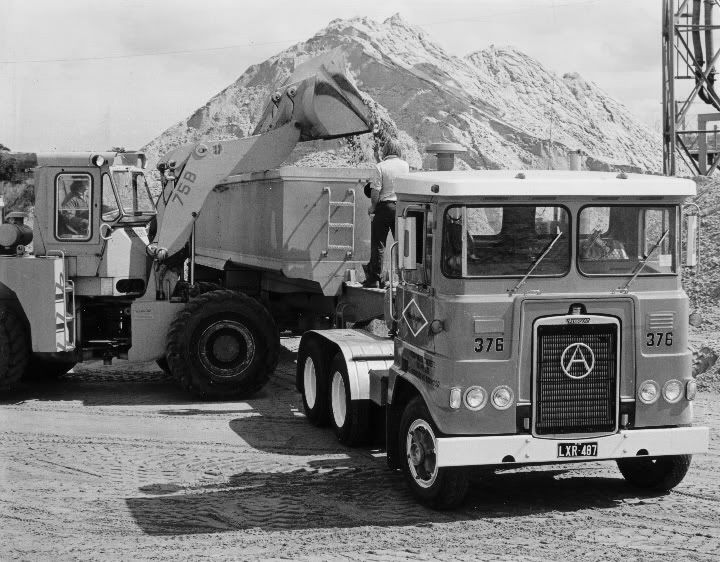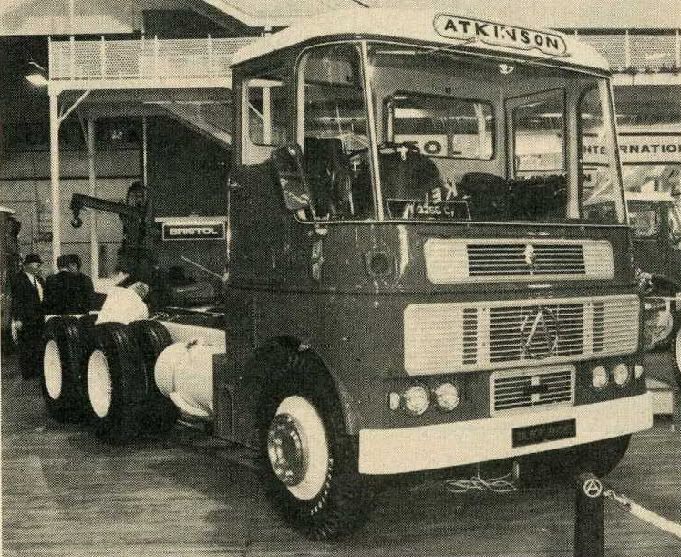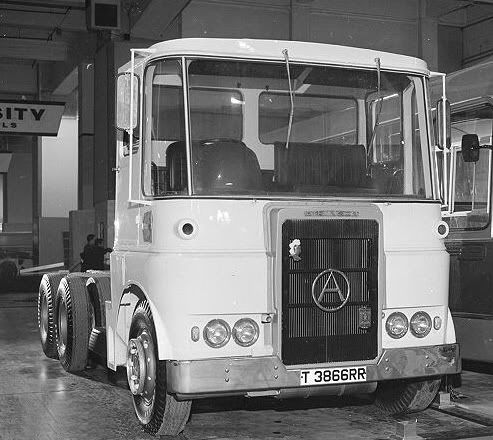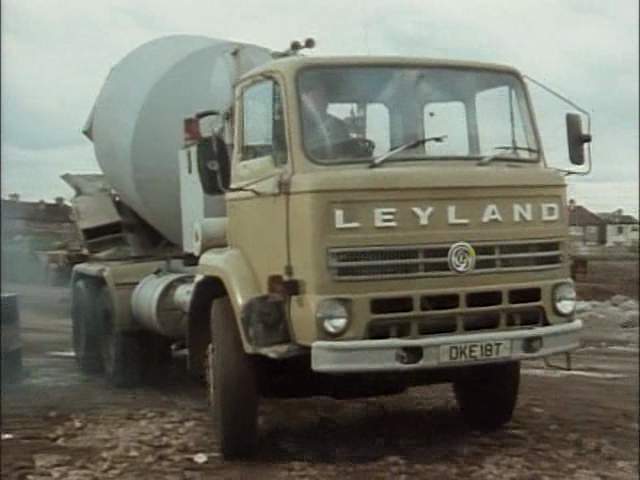I`ve just been reading some posts on here and keep reading how good the foreign vehicles were that killed the British Lorry manufacteuring industry.Was it that they were so good or could it have been that ours were so bad.The offerings from here were pretty poor driver comfort wise so it probably only took a well insulated (noise,) and warm cab ,that was put together fairly well to compete.Which British lorry builder would have dared to put a radio into 1 of there vehicles as standard in the 60s ,it would have been a waste of time due to the interior engine noise .Also a synchro box ,not to everyones taste but standard on the Swedes made them more attractive to drive.The Swedes had bigger engine power outputs at the top end of their ranges but dont forget they ran at much higher weights at home with much colder conditions.Could it be that the UK market was a piece of cake for them as they were already producing vehicles designed for much harsher weather conditions operating at high gross weights
Didn’t British tippers tend to be lighter than the foreign ones? MANs were way heavier than Leyland Constructors/Leyland Daf 80s. We still had a G reg Constructor when I started on the shovels which carried just over 19 ton plated at 30.4 yet our 08 reg MAN carries the same payload at 32.
Muckaway:
Didn’t British tippers tend to be lighter than the foreign ones? MANs were way heavier than Leyland Constructors/Leyland Daf 80s. We still had a G reg Constructor when I started on the shovels which carried just over 19 ton plated at 30.4 yet our 08 reg MAN carries the same payload at 32.
I think ,but could be wrong that the Scammell Routeman was the lightest 8 wheeler .I remember an AEC Mandator my dad drove could carry 22.5 tons with a tandem flat trailer gross weight 32 tons.But looking at it there was nothing to them so no weight especially the cab.
I can only speak for tipper’s but yes, the British stuff did tend to be lighter. Reiver’s could carry 17 + tonnes running at 24 ton gross, I THINK that the Volvo 6 wheeler’s that Tarmac have nowaday’s can only manage around 15 1/2 tonnes at 26 ton gross but my F reg Foden could manage 17 tons AND it was a comfy lorry to drive! My old gaffer would have had a fit at that (lack of) payload, and with 8 wheeler’s our old Foden half cab’s and the S39 range could carry nearly 21 tons at 30.50 gross whereas Volvo’s could only scrape just above 20 tons running at 32 gross. I always thought that you ran truck’s for profit, maybe I have that all wrong but driver’s nowadays seem to expect the comfort of a luxury car! When you are paid on earnings every cwt counts, half a ton less each load can make a lot of difference in the wage packet believe me! ![]()
Pete.
Hi,
I had my reiver with sleeper and steel body uprated to 26t with larger wheels and tyres, it could carry almost 18t, the last constructer I had in the 90’s carried 15.5t.
I think it was called progress !
We had Iveco Turbostars with rear lift axles and tri axle curtainsider trailers with unladen weight of 15 1/2 tons giving 22.5 ton payload at 38 ton comfortable motors but at a price
Ive just seen an official AEC Mammoth Major mk 3 advertisement that dates from 1954 , in the options section theres power steering the 11.3 engine and a 6 speed box listed at extra cost.I think someone mentioned this on here that uk hauliers wouldn`t pay for anything more than a basic lorry,it would be interesting to see how many did…power steering in 1954■■?
windrush:
I can only speak for tipper’s but yes, the British stuff did tend to be lighter. Reiver’s could carry 17 + tonnes running at 24 ton gross, I THINK that the Volvo 6 wheeler’s that Tarmac have nowaday’s can only manage around 15 1/2 tonnes at 26 ton gross but my F reg Foden could manage 17 tons AND it was a comfy lorry to drive! My old gaffer would have had a fit at that (lack of) payload, and with 8 wheeler’s our old Foden half cab’s and the S39 range could carry nearly 21 tons at 30.50 gross whereas Volvo’s could only scrape just above 20 tons running at 32 gross. I always thought that you ran truck’s for profit, maybe I have that all wrong but driver’s nowadays seem to expect the comfort of a luxury car! When you are paid on earnings every cwt counts, half a ton less each load can make a lot of difference in the wage packet believe me!Pete.
Payloads have certainly gone down…When Dad came off the 6 wheeler your boss bought of us he went on a B reg 8w Foden with Wilcox alloy body at 30.5 gvw. It carried a good 20 tonnes. He then had a G reg with steel Charrold body (uprated to 32) that carried 20. When that got nicked he got Smiths first 3000 sries with steel that carried almost 20.5. Now, apart from an alloy bodied Alpha none of our 8ws can get 20 ton on-progress indeed…
Maybe its all these neccessary additions we need nowadays that put the weight up like Adblue and the tank its carried in all in the name of global warming … by the way as anyone looked out their window lately its more like the ice age,think we will get a tax rebate for this stealth tax lie?
ramone:
I`ve just been reading some posts on here and keep reading how good the foreign vehicles were that killed the British Lorry manufacteuring industry.Was it that they were so good or could it have been that ours were so bad.The offerings from here were pretty poor driver comfort wise so it probably only took a well insulated (noise,) and warm cab ,that was put together fairly well to compete.Which British lorry builder would have dared to put a radio into 1 of there vehicles as standard in the 60s ,it would have been a waste of time due to the interior engine noise .Also a synchro box ,not to everyones taste but standard on the Swedes made them more attractive to drive.The Swedes had bigger engine power outputs at the top end of their ranges but dont forget they ran at much higher weights at home with much colder conditions.Could it be that the UK market was a piece of cake for them as they were already producing vehicles designed for much harsher weather conditions operating at high gross weights
Now Ramone I can tell you that there was one British manufacturer in the late 50s that put a Radio,Cig lighter and IIRC a shaver point in their cabs!!!This was the new Guy cab that was launched in '59.You probably couldn’t hear the radio when moving,I’ll agree,but the thought was there!!! Cheers Dennis.
why did the aussies/kiwis/s.africans seem to get the better trucks from atkinsons and erf ? i’m sure someone could stick up some of the type of models i’m thinking of, they seemed to be a better type of truck than the ones run in the uk and had bigger cabs etc.
glenman:
why did the aussies/kiwis/s.africans seem to get the better trucks from atkinsons and erf ? i’m sure someone could stick up some of the type of models i’m thinking of, they seemed to be a better type of truck than the ones run in the uk and had bigger cabs etc.
I think both Atkinson and ERF had assembly plants in both S.Africa and Austrailia so there was a good local in-put into what level of durability that was required.I know a chap that worked at Atkinson in S.Africa for a number of years and the Boers operated in much tougher conditions than we encountered in the UK.Bewick.
were some erf’s made for europe not better than what the local driver got ? bigger cabs/sleepers etc
Bewick:
I think both Atkinson and ERF had assembly plants in both S.Africa and Austrailia so there was a good local in-put into what level of durability that was required.I know a chap that worked at Atkinson in S.Africa for a number of years and the Boers operated in much tougher conditions than we encountered in the UK.Bewick.
Mr. Fowler, I presume?
AEC assembled vehicles in Australia and before the Ergo was introduced local cabs were made for them but that was just the same over here with Park Royal,Tillotson and Duramin.I did hear a tale about a local haulier who bought a new mandator which was a cancelleed export vehicle and the driver reckoned it had a leather interior…dont know how true that was
Bewick:
glenman:
why did the aussies/kiwis/s.africans seem to get the better trucks from atkinsons and erf ? i’m sure someone could stick up some of the type of models i’m thinking of, they seemed to be a better type of truck than the ones run in the uk and had bigger cabs etc.I think both Atkinson and ERF had assembly plants in both S.Africa and Austrailia so there was a good local in-put into what level of durability that was required.I know a chap that worked at Atkinson in S.Africa for a number of years and the Boers operated in much tougher conditions than we encountered in the UK.Bewick.
Yes, Atkinson had plants in SA, Australia & New Zealand - as in the U.K., they built what their customers wanted to buy!
U.K. Atkis were old-fashioned-looking lorries, sure, but there was even a group of customers who formed a deputation to object to the Mk.2 cab being fitted with the concealed radiator in 1968! Imagine what a fit they might have had if they’d been presented with a South African or Australian Atkinson like these:


The customers were so distressed by this:

that it had to be re-worked into this:

And even after that, they still preferred to opt for this:

only themselves to blame for the demise then.
ramone:
Maybe its all these neccessary additions we need nowadays that put the weight up like Adblue and the tank its carried in all in the name of global warming … by the way as anyone looked out their window lately its more like the ice age,think we will get a tax rebate for this stealth tax lie?
AdBlue have certainly added weight to our DAFS when compared to the Alphas. About 100-150 kgs I think.
Frankydobo:
Was a “Transcon” a British truck?
Thought they were built in Holland ?We don’t want to really get into where a British or Foreign owned vehicle was assembled, it was a minefield back then as it is now, just because we have Volvo or MAN on the grille doesn’t mean much and back in British Leyland days it was the same. Yes the Transcons were assembled in Amsterdam although they were designed in the UK albeit with a slightly varied Berliet cab, American ■■■■■■■ engine built in Britain etc etc, the assembly was returned to Britain in 1981, to the Paccar owned Sandbach Engineering (ring a bell) as they had the spare room shall we say to build them.
Many people talk about Swedish trucks too, but what is Swedish? When it is built in Angers in France or in Gent in Belgium or even built by British workers from Irvine in Scotland.
Picture Plagiarism through the 70’s ![]()






When Boris Johnson became the mayor of London he said he would rid the streets of bendi buses and reintroduce Routemaster style buses.I haven`t heard who was going to build them but if true surely Paccar would have been interested as they will own the AEC name